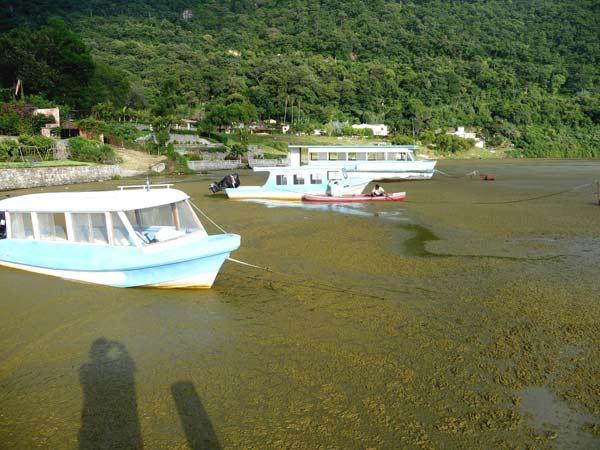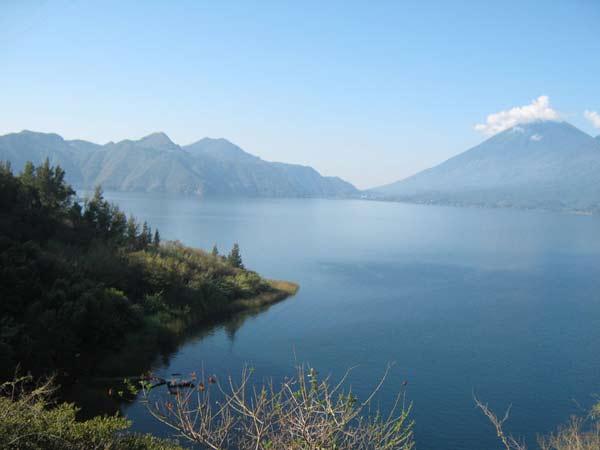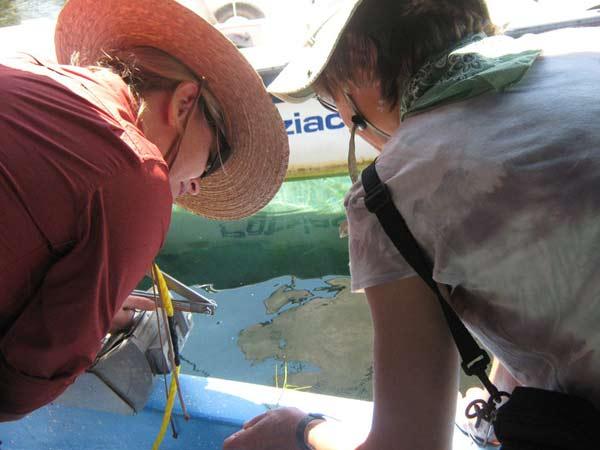
Pollution, Algae Mar Beautiful Lake

Editor's Note: This story has been changed to reflect the correct location of Lake Tahoe and the formation of Lake Atitlan.
Guatemala's Lake Atitlan, long considered a beautiful tourist destination, has been beset by dense, slimy algae blooms that threaten the ecological and economic health of the region.
On a recent South American expedition, scientists searched for environmental solutions to the lake's pollution problems.
Lake Atitlan is a large, tropical lake that was formed by volcanic activity about 84,000 years ago; it is surrounded by three volcanoes with 10,000-foot peaks and is accessed via a road through a cloud forest. The lake itself sits at an elevation of 5,100 feet (1,550 meters). It is 11 miles (18 kilometers) long and covers an area of about 50 square miles (130 square km).
With a depth estimated at 1,116 feet (340 m), Atitlan is deeper than many of the Great Lakes, and is, according to University of Nevada, Reno researcher Sudeep Chandra, incredibly rare. "Lake Atitlan is one of the gems of the world, ecologically and scientifically," said Chandra, who was part of the expedition team to study the lake.

Not only does the beauty of the lake bring in millions of tourism dollars every year, but the 400,000 people people living in 12 towns around the lake depend on it for freshwater, which is used for drinking, showering, and laundry, as well as for sustenance the lake's fisheries provide food for the region.
But since December 2008, dense algal blooms have threatened the lake's ecosystem and the region's livelihood.
Sign up for the Live Science daily newsletter now
Get the world’s most fascinating discoveries delivered straight to your inbox.
Threatened lake
The blue-green blooms of cyanobacteria are the direct result of sediment pollution from erosion, agricultural run-off in the form of fertilizer, and sewage wastewater (the towns around the lake lack sufficient sewage treatment plants).
These pollution factors have come together to increase the levels of nitrogen and phosphorous, which are present in the pollutants, in the lake basin a process known as eutrophication. The increase in nutrients, in combination with warm regional temperatures, has created the perfect breeding ground for algae, which comes with serious consequences.
Dense algae can suck up all the oxygen in the water, creating what are called anoxic conditions that kill fish in the lake.
Moreover, algae blooms create "house and home for other types of microbes in the lake, such as E. coli," Chandra said.
Additionally, some species of cyanobacteria are known to produce a cyanotoxin that's harmful to humans. While there is no indication that the blue-green algae on Lake Atitlan is producing such toxins, the region is concerned. To top it off, when the mass of growing algae dies, the air fills with the smell of the decaying biomass.
"Eutrophication can change the whole character of a lake to the point that it becomes dangerous for humans," says Eliska Rejmankova, a professor in the Department of Environmental Science and Policy from University of California, Davis, who initiated the collaborative project.
About 18 months ago, in December 2008, for the first time blooms combined to cloud over the lake's water, which is usually clear down to a depth of about 60 feet, and turned it a yellowish-brown color. After clearing up in early 2009, the blooms returned again, more extensively, in October 2009.
In 2009, the Global Nature Fund designated Guatemala's Lake Atitlan as its "Threatened Lake of the Year."
Not too late
To see how bad the lake's situation was and see what could be done to save it, a 38-member team, made up of eleven investigators from the United States, Guatemala and the Czech Republic, descended on the highland lake in April for two weeks to assess the lake's health, as well as train local students in limnology (the study of inland waters such as lakes and marshes) and conservation techniques.
They found that the eutrophication happening in Lake Atitlan is in its early stages, and so the process can be mitigated.
In an effort to help gather data that the Guatemalan government might use to create a Lake Atitlan management plan, the expedition team used the April trip to begin assessing the lake and the surrounding watershed.
Scientists gathered water samples throughout the water column, as well as sediment cores, cylinders of soil, from the lake floor. They also gathered samplings of invertebrates, algae, water, sediments and plants from shallow areas near the shore.

Team members also checked out the surrounding watershed to gain a better understanding of regional activities that may be impacting the lake, such as agriculture. The international team also used the expedition to train locals, ages 19 to 32, so that they might take up the charge of protecting the lake themselves.
Today, the samples collected in April are currently being analyzed for chemical, physical and biological properties, such as nutrient concentration or the presence of cyanotoxin. Each piece of data can be used to help shape a regional management plan that will maintain the clarity of the lake and the beauty of this unique region.
The scientists are confident that they've caught the eutrophication process early enough that it can be brought under control, just as it was at another tourist-friendly lake, Lake Tahoe, on the border of California and Nevada, in the 1970s.
At Atitlan, "there will be another bloom, there's no doubt about it," Rejmankova said. "But this lake is not dying."
Since the trip in April, some of the original members returned to Lake Atitlan in June to undertake more sampling, with another trip planned for August.









